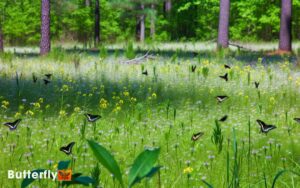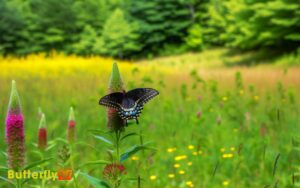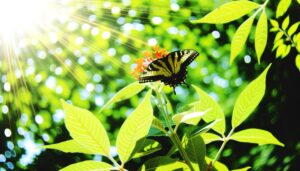Does a Swallowtail Butterfly Caterpillar Look Like It Has Distinct Features?
Swallowtail butterfly caterpillars display distinct appearances through their life stages. Early instars mimic bird droppings with black and white colors.
As they mature, they turn green with black bands accented by yellow or orange spots. These vibrant bands and eye spots serve as anti-predator adaptations.
The caterpillars are cylindrical, ranging from 2 to 5 centimeters in length with an osmeterium for chemical defense. Color variations arise from genetic and environmental influences, aiding in camouflage and warning.
Detailed examination reveals additional intriguing characteristics.
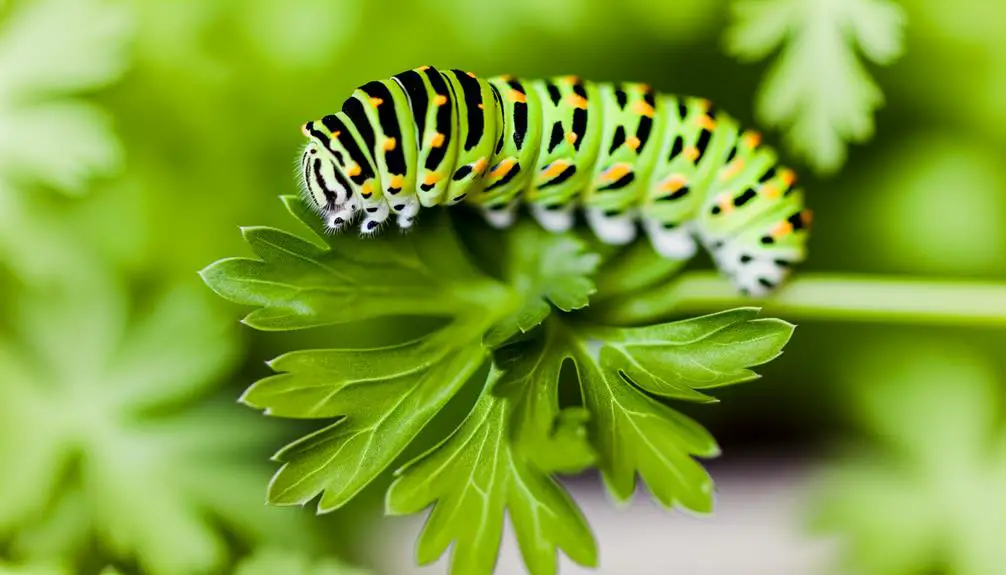
Key Takeaways
- Early instar larvae mimic bird droppings with white and black coloration.
- Mature caterpillars are green with black bands and yellow/orange spots.
- They feature osmeterium, which emit defensive chemicals when threatened.
- Bright contrasting bands and eye spots serve as anti-predator adaptations.
General Appearance
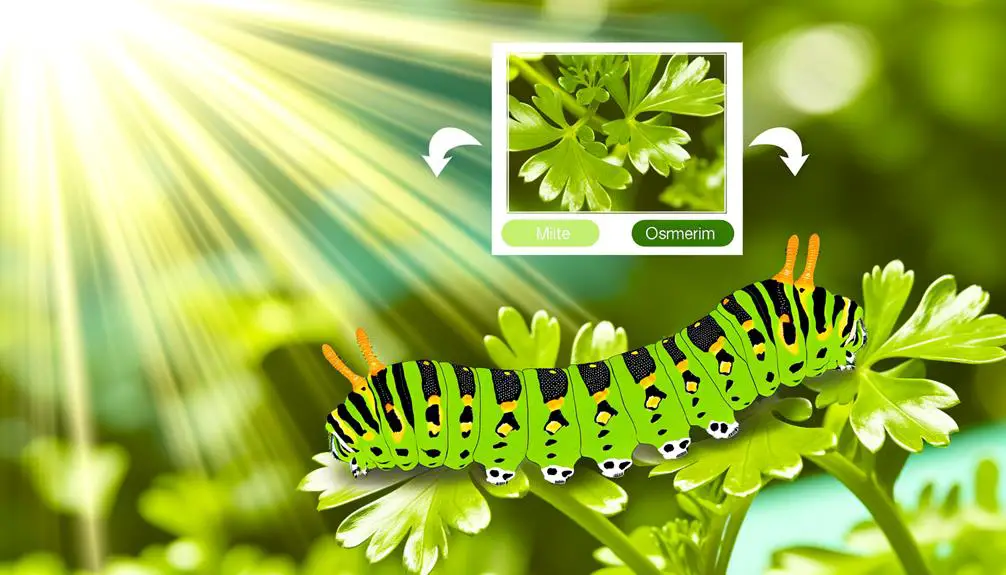
The general appearance of the Swallowtail butterfly caterpillar is characterized by its distinctive coloration and unique patterning, which vary considerably at different stages of its development.
Typically, early instar larvae exhibit a bird-dropping mimicry, featuring a blend of white and black to deter predators. As they mature, the caterpillars shift to a striking green hue adorned with black bands and yellow or orange spots. These visual adaptations serve both as camouflage and a warning signal to potential threats.
Additionally, the caterpillar possesses a specialized organ called the osmeterium, a forked gland located behind its head. When threatened, it extrudes this structure, releasing a foul-smelling substance to ward off predators, showcasing a fascinating blend of visual and chemical defense mechanisms.
Color Variations
Color variations in Swallowtail butterfly caterpillars are influenced by genetic factors, environmental conditions, and developmental stages. These caterpillars exhibit a spectrum of hues ranging from vibrant greens and yellows to more subdued browns and blacks.
Genetic polymorphism often results in distinct color morphs within the same species, providing adaptive advantages such as camouflage or mimicry. Environmental conditions, including light exposure and temperature, further modulate pigmentation, facilitating survival in diverse habitats.
During their developmental stages, Swallowtail caterpillars undergo significant color transformations, starting with early instars that may be cryptically colored to avoid predation, progressing to later instars that often display more conspicuous coloration.
These dynamic color variations underscore the intricate interplay between genetics, environment, and growth in Lepidopteran larvae.
Distinctive Markings
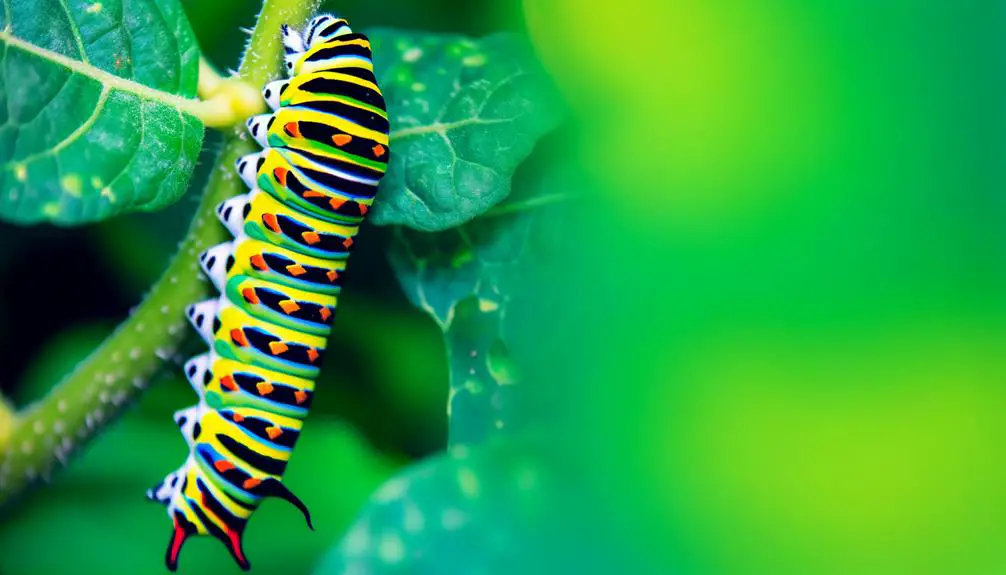
Distinctive markings on swallowtail butterfly caterpillars include a series of color patterns that vary by species and developmental stage.
Commonly observed are bright, contrasting bands and eye spots that serve as anti-predator adaptations.
Additionally, these caterpillars often exhibit unique features such as osmeteria, glandular structures that emit defensive chemicals.
Color Patterns
Swallowtail butterfly caterpillars exhibit a variety of intricate color patterns that serve both as camouflage and a warning to potential predators.
Early instars often display hues of black and white, mimicking bird droppings to evade detection. As they mature, these caterpillars undergo a striking transformation, adopting vivid shades of green, yellow, and black.
These colors are frequently arranged in bands or spots, creating a striking visual contrast. Some species feature false eyespots on their thoraxes, which further deter predators by simulating larger, more threatening creatures.
This complex coloration not only enhances their survival but also underscores the evolutionary intricacies that contribute to their distinctiveness. The dynamic interplay of colors in swallowtail caterpillars exemplifies nature's sophisticated mechanisms for adaptation.
Unique Features
One of the most remarkable features of swallowtail butterfly caterpillars is the presence of osmeteria, specialized, forked organs that can be everted from behind the head to emit a foul-smelling chemical as a defense mechanism against predators.
In addition to osmeteria, several other distinctive markings and adaptations make these caterpillars unique:
- Eye Spots: Many species possess eye-like markings on their thorax, which can deter predators by mimicking the eyes of larger animals.
- Color Changes: Some swallowtail caterpillars can alter their coloration through various developmental stages, enhancing camouflage.
These unique features underscore the remarkable adaptations of swallowtail butterfly caterpillars for survival.
Size and Shape
The Swallowtail butterfly caterpillar typically measures between 2 to 5 centimeters in length, depending on its developmental stage.
Its body exhibits a cylindrical shape, tapering slightly towards both ends, which facilitates efficient mobility and feeding.
The coloration and patterns vary considerably among species, often including striking combinations of green, black, and yellow, which serve as both camouflage and warning signals to potential predators.
Typical Caterpillar Length
Typically ranging from 1.5 to 2 inches in length, the swallowtail butterfly caterpillar exhibits a cylindrical body shape that is both robust and variable in coloration depending on its developmental stage. This size range is indicative of the caterpillar's growth phase, reflecting its nutritional intake and overall health.
The caterpillar's dimensions allow for efficient mobility and feeding on host plants, critical for its survival and metamorphosis.
Key aspects of the swallowtail butterfly caterpillar's length include:
- Variability: Length can slightly fluctuate based on environmental conditions and genetic factors.
- Growth Stages: Different instars (developmental stages) reveal incremental increases in length.
These factors collectively contribute to the caterpillar's adaptability and success in various habitats.
Body Shape Characteristics
Characterized by its cylindrical and robust body, the swallowtail butterfly caterpillar exhibits morphological adaptations that enhance its feeding efficiency and protect against predation.
Typically measuring between 2 to 5 centimeters in length, the caterpillar's body is composed of twelve discernible segments, each contributing to its overall structural integrity.
The anterior segments house the head capsule equipped with powerful mandibles for efficient folivory. The thoracic segments possess three pairs of true legs, while the abdominal segments feature prolegs with tiny hooks, known as crochets, that provide stability on vegetation.
The body's cylindrical shape not only facilitates efficient locomotion but also aids in cryptic behavior, reducing exposure to predators. This anatomical design represents an evolutionary balance between mobility and defense mechanisms.
Coloration and Patterns
Beyond its body shape characteristics, the swallowtail butterfly caterpillar exhibits a remarkable array of coloration and patterns that serve both protective and signaling functions. The vibrant hues and intricate designs on its body provide effective camouflage and deter potential predators. Typically, these caterpillars display a combination of green, black, and yellow with distinctive patterns.
- Camouflage: The green coloration allows the caterpillar to blend seamlessly with foliage, rendering it nearly invisible to predators.
- Warning Colors: Bright yellow spots and bands serve as aposematic signals, warning predators of the caterpillar's potential toxicity.
These adaptive strategies highlight the caterpillar's evolutionary ingenuity.
Defensive Mechanisms
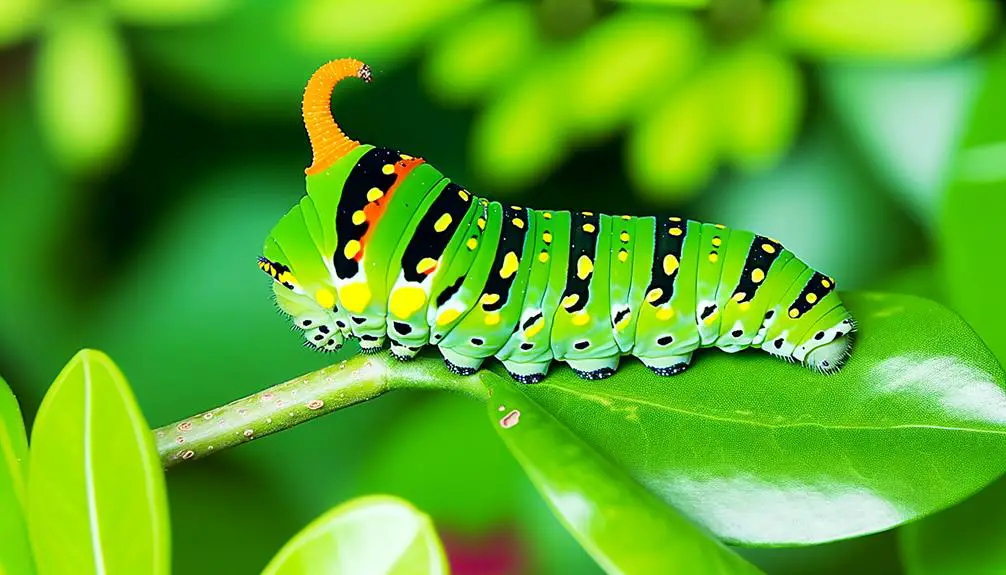
Swallowtail butterfly caterpillars possess several sophisticated defensive mechanisms to protect themselves from predators.
One notable feature is the osmeterium, a forked gland located behind the head. When threatened, the caterpillar everts this gland, releasing a foul-smelling secretion that deters potential attackers.
Additionally, many swallowtail caterpillars exhibit mimicry; young larvae often resemble bird droppings, providing camouflage against visual predators. As they mature, their bright coloration can signal toxicity, a strategy known as aposematism.
Moreover, some species can inflate their bodies to appear larger and more intimidating.
These adaptive strategies collectively enhance the caterpillar's ability to survive in a predatory environment, ensuring they reach maturity and contribute to the continuation of their species.
Habitat and Host Plants
Thriving in a variety of ecosystems, swallowtail butterfly caterpillars primarily inhabit regions where their specific host plants are abundant. These caterpillars exhibit a strong preference for certain flora, which provides both nourishment and an ideal environment for growth and development. Their habitats range from dense forests to suburban gardens, demonstrating remarkable adaptability.
Key host plants include:
- Apiaceae family: Species such as dill, fennel, and parsley.
- Rutaceae family: Citrus plants, including lemon and orange trees.
These host plants are essential for the caterpillar's sustenance and are selected based on their chemical compositions, which caterpillars utilize for both feeding and defense mechanisms.
This selective feeding behavior guarantees the survival and continuity of swallowtail butterfly populations.
Life Cycle Stages
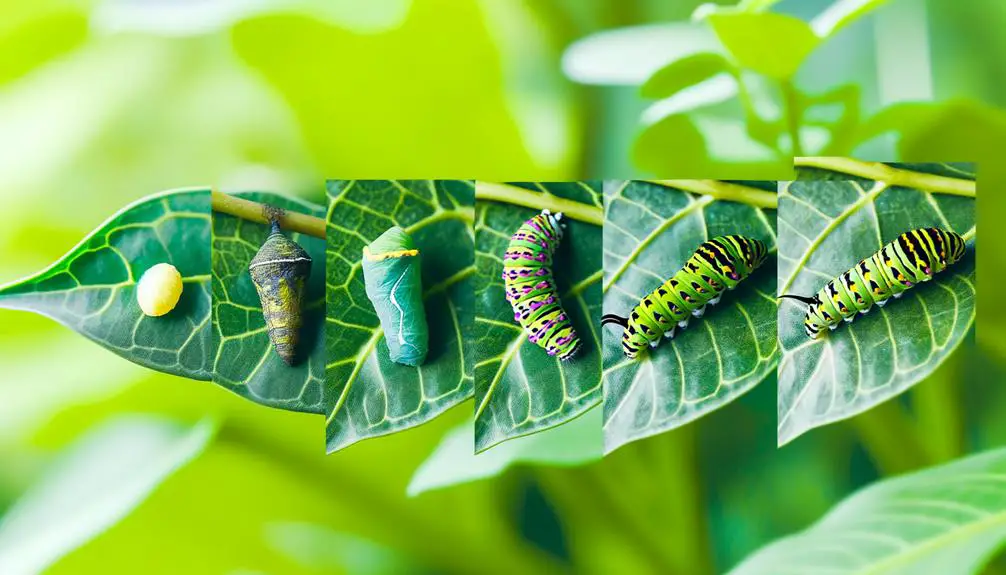
The life cycle of a swallowtail butterfly encompasses four distinct stages: egg, larva (caterpillar), pupa (chrysalis), and adult.
During the egg stage, females lay spherical, minute eggs on host plants.
The larva emerges and undergoes several instars, transforming from a bird-dropping mimic to a vibrant caterpillar adorned with distinctive markings.
In the pupal stage, the caterpillar forms a chrysalis, undergoing metamorphosis within a protective casing.
Finally, the adult butterfly emerges, characterized by striking wing patterns and vibrant colors.
Each stage is meticulously timed and essential for the survival and reproduction of the species, reflecting a highly evolved and intricate life cycle that guarantees the continuation of these fascinating insects.
Role in Ecosystem
Understanding the role of swallowtail butterflies in the ecosystem reveals their importance as pollinators, prey, and contributors to biodiversity.
These butterflies facilitate cross-pollination, enhancing genetic diversity among flowering plants. Their larvae and adults serve as an essential food source for various predators, including birds and small mammals, thereby maintaining ecological balance. In addition, the presence of swallowtails indicates a healthy environment, as they are sensitive to habitat changes and pollution.
- Pollination: Swallowtails contribute to the reproduction of diverse plant species.
- Food Source: Both caterpillars and adult butterflies are integral to the food webs of their habitats.
This multifaceted role underscores their ecological significance.
Conclusion
The swallowtail butterfly caterpillar, with its astonishing array of colors and distinctive markings, presents a visual marvel of nature. As it progresses through its life cycle, it undergoes remarkable transformations that captivate observers. Early on, the swallowtail butterfly eggs appearance is equally fascinating, often characterized by their tiny, spherical shape and subtle coloration that helps them blend into their surroundings.
Its varying hues and defensive mechanisms, such as osmeteria, make it a subject of intense scientific interest.
Found mainly on specific host plants, the caterpillar's life cycle stages contribute greatly to ecosystem dynamics.
This seemingly unassuming larva plays an immensely vital role in maintaining ecological balance, offering endless fascination to entomologists and nature enthusiasts alike.

